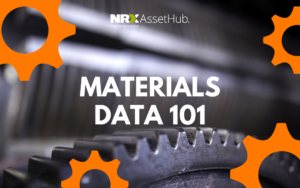Spare parts are some of the smallest subunits within the inventory of an EAM system. They typically fall lower in an organization’s hierarchy of assets. Yet spare parts are the foundation of an asset-intensive business’ success. If they’re not well maintained, poor quality spare parts that belong to vital equipment are going to hinder how well workers are able to do their jobs. Not only does this mean that you should ensure the condition of your spare parts is good, it also means ensuring that the information you have about your spare parts is accurate. After all, you can strategically source spare parts when you know your materials data. Your materials data can tell you what kind of spare parts you have, what kind of spare parts you need, and how much you’re spending on them overall (regardless whether you even need them or not). In fact, misorders are a common result of poorly maintained materials data, which is why knowing your spare parts and where they come from can save your business money in the long term.
Strategically source your spare parts
For the most part, spare parts are going to be ordered from original equipment manufacturers (OEMs). These organizations are going to be able to tell you the most about the nature of the spare parts needed for your equipment since they made that equipment in the first place. Buying spare parts from OEMs can sometimes be expensive, but without the knowledge of what kind of spare parts they need, an asset manager may feel they have no other choice but to turn to an OEM. An EAM system filled with strong, accurate, and detailed descriptions of its spare parts enables managers to take what they know about the spare parts they need and seek out those parts elsewhere. You may be able to find other vendors who can offer these spare parts at a reduced price. (But be careful! Cheap spare parts are not necessarily quality spare parts, and sometimes paying an OEM more for a spare part is worth the assurance of quality and safety.) But little to no knowledge of the attributes of the spare parts needed may mean little to no power to decide where to buy them.

What’s more, you may find that you don’t even need to order more spare parts in the first place. Asset managers may sometimes find themselves accumulating an excessive inventory of a particular part, all because they couldn’t find out if this part even needed to be replaced in the first place. The data in their EAM system is poorly organized and not easily searched. Better safe than sorry, and so it seems better to be overprepared than underprepared for equipment maintenance by buying more replacement parts, even if they’re not needed. But spending money on stockpiling these spare parts takes away the power to make informed and strategic decisions on where to buy spare parts from, what spare parts to buy, and what quantity to buy them in.
What can cleansing do?
The root cause of the poor purchasing processes outlined above is poor data quality. Duplicate parts, misnamed parts, or inaccurate parts descriptions are all factors that make searching for information about materials data more difficult. Making your spare parts data easier to manage and understand with a materials cleanse can empower you and your workers to make strategic sourcing decisions when it comes to buying replacement parts. Aside from ensuring that you’re getting the best value out of the parts you buy, a materials cleanse can save you money for many other reasons too! To learn more, check out one of our resources below, or book a demo with us to learn about how NRX Assethub can help you start saving money.
Materials Data 101

Knowing your Spare Parts Dictionary from A to Z

Standardizing Your Spare Parts Data with a Materials Cleanse

Share this article

